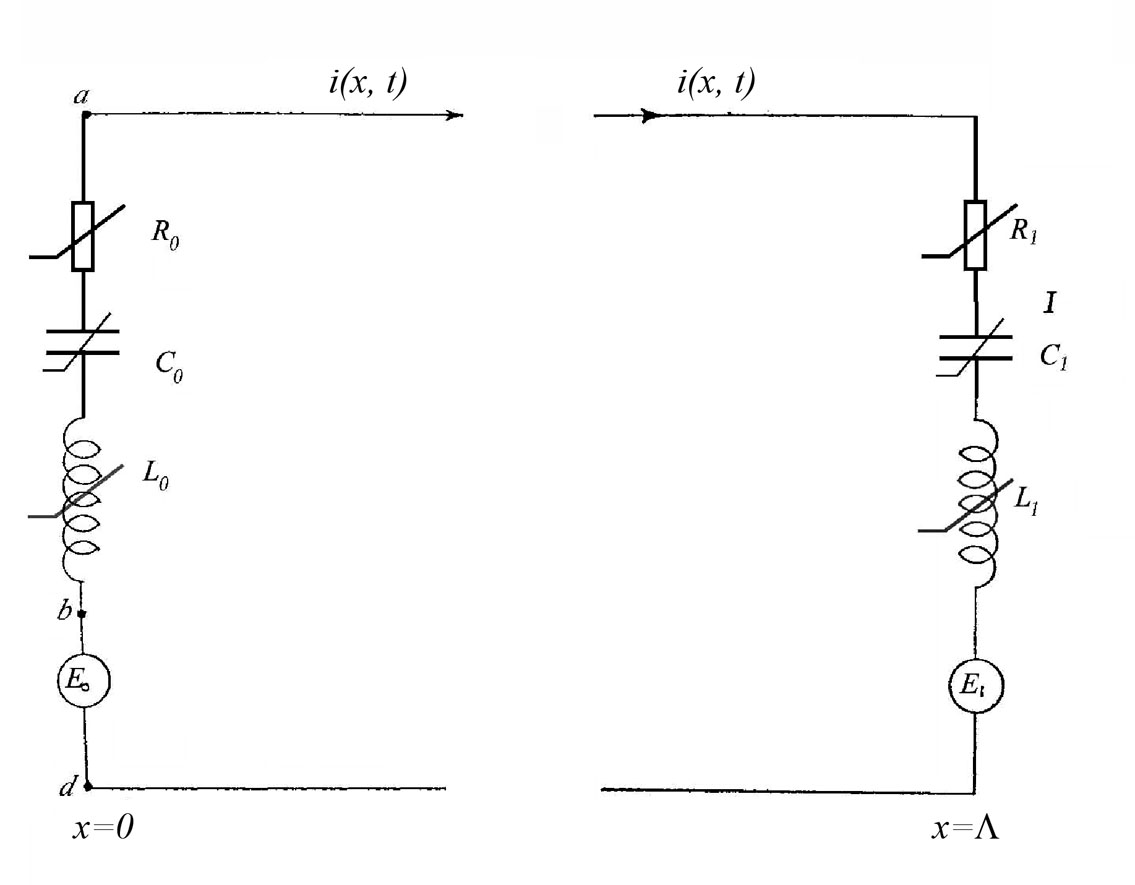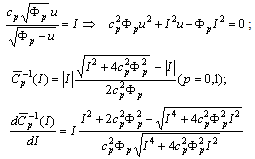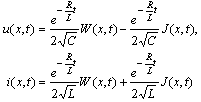-
Paper Information
- Previous Paper
- Paper Submission
-
Journal Information
- About This Journal
- Editorial Board
- Current Issue
- Archive
- Author Guidelines
- Contact Us
International Journal of Theoretical and Mathematical Physics
p-ISSN: 2167-6844 e-ISSN: 2167-6852
2012; 2(5): 143-162
doi: 10.5923/j.ijtmp.20120205.08
Oscillations in Lossy Transmission Lines Terminated by in Series Connected Nonlinear RCL-Loads
Vasil Angelov
Department of Mathematics, University of Mining, Geology “St. I. Rilski”, Sofia, 1700, Bulgaria
Correspondence to: Vasil Angelov , Department of Mathematics, University of Mining, Geology “St. I. Rilski”, Sofia, 1700, Bulgaria.
| Email: |  |
Copyright © 2012 Scientific & Academic Publishing. All Rights Reserved.
We formulate conditions for an existence-uniqueness of oscillatory regimes in transmission lines terminated by in series connected nonlinear RGLC-loads. This is achieved by introducing suitable operator whose fixed point is a seeking solution. The method allows obtaining approximated solutions and an estimate of the rate of convergence.
Keywords: Lossy Transmission Lines, RCL-Loads, Oscillatory Solution, Neutral Functional Differential Equation, Fixed Point Theorems
Article Outline
1. Introduction
- In a recent paper[1] we have investigated a transmission line terminated by in series connected RCL-loads and we have reduced the mixed problem for the lossy transmission line equations to an initial value problem for a system of neutral equations on the boundary. Then we proved an existence-uniqueness result of periodic boundary value problem for the neutral system obtained but for one period. Global behaviour of the solution is declining rather than periodically. In contrast to parallel connected RCL-loads (cf.[2]) here the multiplier
 could not be eliminated and this implies that the solution vanishes exponentially. From the physical point of view this means that the signal vanishes in time. Moreover one can notice the voltage and current in the lossy transmission line are products of a periodic function and an exponential function, that is,
could not be eliminated and this implies that the solution vanishes exponentially. From the physical point of view this means that the signal vanishes in time. Moreover one can notice the voltage and current in the lossy transmission line are products of a periodic function and an exponential function, that is,
 .Therefore
.Therefore  should be oscillating functions and vanish exponentially at infinity. This suggest us to state the problem for an existence-uniqueness of a global oscillatory solution on
should be oscillating functions and vanish exponentially at infinity. This suggest us to state the problem for an existence-uniqueness of a global oscillatory solution on  vanishing exponentially at infinity. As in[1],[2] we assume the Heaviside condition is satisfied, that is,
vanishing exponentially at infinity. As in[1],[2] we assume the Heaviside condition is satisfied, that is, . It implies that the transmission line is without distortion. Here we omit the reduction (cf.[1]) of the mixed problem for the hyperbolic system to a neutral system on the boundary and prove by the fixed point method (cf.[3]) an existence-uniqueness of the oscillatory solution for the neutral system. The main difficulty is generated by nonlinearities of RLC-loads (cf.[4]-[7]). We obtain successive approximation of the seeking oscillatory solution in an explicit form and estimate the rate of convergence. Especially we want to draw attention to a fundamental disadvantage of lot of papers – solving equations without guaranteed uniqueness of the solution. Whatever the method (numerical, approximated and so on) to apply without uniqueness is not known to which of the many solutions are coming.We mention recent various approaches for an analysis of transmission lines[8]-[15] .We would like to point out that we obtain an approximated solution but in explicit form beginning with simple functions.
. It implies that the transmission line is without distortion. Here we omit the reduction (cf.[1]) of the mixed problem for the hyperbolic system to a neutral system on the boundary and prove by the fixed point method (cf.[3]) an existence-uniqueness of the oscillatory solution for the neutral system. The main difficulty is generated by nonlinearities of RLC-loads (cf.[4]-[7]). We obtain successive approximation of the seeking oscillatory solution in an explicit form and estimate the rate of convergence. Especially we want to draw attention to a fundamental disadvantage of lot of papers – solving equations without guaranteed uniqueness of the solution. Whatever the method (numerical, approximated and so on) to apply without uniqueness is not known to which of the many solutions are coming.We mention recent various approaches for an analysis of transmission lines[8]-[15] .We would like to point out that we obtain an approximated solution but in explicit form beginning with simple functions.2. Mixed Problem for the Lossy Transmission Line System terminated by in Series Connected RCL-Loads
- We proceed from the lossy transmission line equations system:
 | (1) |
 with initial conditions
with initial conditions | (2) |
 >0 is its length and
>0 is its length and  are prescribed functions. Here
are prescribed functions. Here  are unknown functions – voltage and current respectively. The boundary conditions are derived from the loads and sources at the ends of the line (cf.[1], Fig. 1) on the base of Kirchoff’s laws.For
are unknown functions – voltage and current respectively. The boundary conditions are derived from the loads and sources at the ends of the line (cf.[1], Fig. 1) on the base of Kirchoff’s laws.For  we have
we have | (3) |

 | (4) |
 are the prescribed source functions and
are the prescribed source functions and 
 are prescribed nonlinear functions – nonlinear characteristics of the corresponding elements.
are prescribed nonlinear functions – nonlinear characteristics of the corresponding elements.  | Figure 1. Lossy transmission line terminated by nonlinear loads |
 we proceed from the relation (assuming
we proceed from the relation (assuming , where
, where  ):
):  and hence
and hence  , where are constants. Since
, where are constants. Since and
and we consider
we consider  for
for  Since
Since 
 , the inverse function
, the inverse function  exists and
exists and that is,
that is, and hence
and hence | (5) |
 ) is
) is ;We need the following inequality:
;We need the following inequality: .We need also the following estimates:
.We need also the following estimates:  ;
; | (6) |
 is
is  where
where  and then
and then .We get
.We get  We know that (cf.[4]-[7])
We know that (cf.[4]-[7]) For the I-V characteristics we assume that
For the I-V characteristics we assume that .The mixed problem (1)-(4) can be reduced to an initial value problem for a nonlinear neutral system. Recall some transformations from[1]:
.The mixed problem (1)-(4) can be reduced to an initial value problem for a nonlinear neutral system. Recall some transformations from[1]: which reduces (1) to the system
which reduces (1) to the system | (7) |
 .Assume that the unknown functions are (cf.[1])
.Assume that the unknown functions are (cf.[1])  .and taking into account the relations obtained after integration along the characteristics
.and taking into account the relations obtained after integration along the characteristics  we obtain the system (cf.[1]):
we obtain the system (cf.[1]):


 Principal Remark. If
Principal Remark. If  are periodic functions then the functions
are periodic functions then the functions  should be oscillatory ones. They should satisfy the following inequalities
should be oscillatory ones. They should satisfy the following inequalities  Further on we again denote them by
Further on we again denote them by  that is,
that is, .So omitting some transformations given in details in[1] we reach the problem for existence-uniqueness of oscillatory solution
.So omitting some transformations given in details in[1] we reach the problem for existence-uniqueness of oscillatory solution  of the following system:
of the following system:


 | (8) |
 where
where The initial functions are obtained as in[1].First we formulate the conditions for the initial functions (IN)
The initial functions are obtained as in[1].First we formulate the conditions for the initial functions (IN)  .Assume that one can find an interval
.Assume that one can find an interval  such that the inequalities
such that the inequalities  | (9) |

 This can be done if the polynomial has suitable properties (cf. Numerical example).
This can be done if the polynomial has suitable properties (cf. Numerical example).3. An Existence-Uniqueness of Oscillatory Solution for the Neutral System
- Here we introduce an operator representation of the oscillatory problem and by a fixed point theorem in uniform spaces[3] we establish an existence-uniqueness of global oscillatory solution. Now we are able to formulate the main problem: to find a solution of (8) with advanced prescribed zeros on an interval
 where
where  are prescribed initial oscillating functions on the interval
are prescribed initial oscillating functions on the interval  . Let
. Let  (such that
(such that  ) be the set of zeros of the initial functions, that is,
) be the set of zeros of the initial functions, that is,  .Let
.Let  be a strictly increasing sequence of real numbers satisfying the following conditions (C):(C1)
be a strictly increasing sequence of real numbers satisfying the following conditions (C):(C1)  ; (C2) for every k there is
; (C2) for every k there is  such that
such that  where
where  .(E)
.(E)  .It follows
.It follows 

 ;Introduce the sets
;Introduce the sets  consisting of all continuous and bounded functions differentiable with bounded derivatives on every interval
consisting of all continuous and bounded functions differentiable with bounded derivatives on every interval  .Remark 3.1. Let us note that the left and right derivative at
.Remark 3.1. Let us note that the left and right derivative at  of any
of any  may not coincide. This requires introducing of uniform spaces[3] with a suitable topology for continuous functions with piece wise continuous derivatives. Introduce the sets
may not coincide. This requires introducing of uniform spaces[3] with a suitable topology for continuous functions with piece wise continuous derivatives. Introduce the sets Remark 3.2. Conditions (C2) and (E) imply that if
Remark 3.2. Conditions (C2) and (E) imply that if  then
then  .Remark 3.3. Let us comment the conformity condition (CC). It could be obtained replacing
.Remark 3.3. Let us comment the conformity condition (CC). It could be obtained replacing  in (8) and in view of
in (8) and in view of  and
and 
 ,where
,where  . We notice that (CC) becomes a relation between the initial functions
. We notice that (CC) becomes a relation between the initial functions 
 . If the last condition is not satisfied then the jump of the derivative at
. If the last condition is not satisfied then the jump of the derivative at  propagates to the right and it falls at some zero point because of
propagates to the right and it falls at some zero point because of  . We do not go beyond our function space because the derivative of our functions might have jumps at
. We do not go beyond our function space because the derivative of our functions might have jumps at  .Remark 3.4. It follows that the functions from
.Remark 3.4. It follows that the functions from  and
and  satisfy the inequalities
satisfy the inequalities 
 where
where  are positive constants and
are positive constants and  Besides we point out that
Besides we point out that  implies the global estimate
implies the global estimate  .Introduce the following family of pseudo-metrics
.Introduce the following family of pseudo-metrics The following inequalities imply the equivalence of the both families of pseudo-metrics
The following inequalities imply the equivalence of the both families of pseudo-metrics It is easy to verify that
It is easy to verify that | (10) |
 The set
The set  turns out into a complete uniform space with respect to the family of pseudo-metrics
turns out into a complete uniform space with respect to the family of pseudo-metrics 
 .Define the operator
.Define the operator  by the formulas
by the formulas The sources
The sources  are continuously differentiable oscillatory functions.Further on the following assumptions will be hold:Assumtion(IN):
are continuously differentiable oscillatory functions.Further on the following assumptions will be hold:Assumtion(IN): 
 Assumtion (E):
Assumtion (E):  ;Assumption (П):
;Assumption (П):  .Lemma 3.1. Problem (8) has a solution
.Lemma 3.1. Problem (8) has a solution 
 iff the operator
iff the operator  has a fixed point in
has a fixed point in  , that is,
, that is,  | (11) |
 be a solution of (8). Then integrating every equation of (8) on
be a solution of (8). Then integrating every equation of (8) on 
 we obtain
we obtain and then
and then | (12) |
 satisfies
satisfies for
for  or
or  , that is,
, that is,  is a fixed point of B.Conversely, let
is a fixed point of B.Conversely, let  be a fixed point of B or
be a fixed point of B or | (13) |
 we obtain
we obtain
 Since
Since  we conclude that
we conclude that  and
and  .Therefore operator equations (13) become
.Therefore operator equations (13) become Differentiating the last integral equations we obtain (8).Lemma 3.1 is thus proved.Preliminary assertions:
Differentiating the last integral equations we obtain (8).Lemma 3.1 is thus proved.Preliminary assertions: ;
;




 6) the function
6) the function  is increasing and
is increasing and  ;
; Theorem 3.1. In addition to conditions (IN), (E) and (П) suppose
Theorem 3.1. In addition to conditions (IN), (E) and (П) suppose

 Then there exists an unique oscillatory solution of (8), belonging to
Then there exists an unique oscillatory solution of (8), belonging to  .Proof: Recall that
.Proof: Recall that  we notice that the function
we notice that the function  is continuous on
is continuous on  . Indeed,
. Indeed, 
 and for
and for  :
: We notice also
We notice also  are differentiable on every interval
are differentiable on every interval  .In order to show that
.In order to show that  we have to establish the following inequalities:
we have to establish the following inequalities: ,
,  .Using Preliminary assertions we have
.Using Preliminary assertions we have






















 For the second component we have
For the second component we have  and then
and then
















 Therefore
Therefore
 So the operator B maps the set
So the operator B maps the set  into itself.In what follows we show that B is contractive operator. The maximum of
into itself.In what follows we show that B is contractive operator. The maximum of  attends for some
attends for some  . Then
. Then  We have
We have










 Therefore
Therefore It follows
It follows
 and consequently
and consequently
 Further on we have
Further on we have We get
We get




















 Therefore
Therefore

 It follows
It follows
 and consequentlyFinally we have to obtain an estimate of the derivatives for
and consequentlyFinally we have to obtain an estimate of the derivatives for  :
: We get
We get











 The last term is bounded because
The last term is bounded because and
and  .Consequently
.Consequently
 Therefore
Therefore
 that is,
that is,  It follows
It follows For the derivative of the second component of B we obtain
For the derivative of the second component of B we obtain
 .We have
.We have




 Then
Then .Then
.Then  It follows
It follows Finally we obtain
Finally we obtain  where
where  might be chosen smaller than 1.Therefore B is contractive operator and has a unique fixed point in M (cf.[3], Theorems 2.2.2 and 2.2.3). It is an oscillatory solution of (8).Thus Theorem 3.1 is thus proved.
might be chosen smaller than 1.Therefore B is contractive operator and has a unique fixed point in M (cf.[3], Theorems 2.2.2 and 2.2.3). It is an oscillatory solution of (8).Thus Theorem 3.1 is thus proved.4. Numerical Example
- Finally we demonstrate of how to apply the above theorem to engineering problems. We collect all inequalities implying an existence-uniqueness of oscillatory solution:
 ;
;  ;
;

 For a transmission line with length
For a transmission line with length 


 ;
;  .For waves with
.For waves with  we have
we have  Let us choose
Let us choose  Then
Then  and
and  . Consequently
. Consequently 


 .We choose resistive elements with V-I characteristics
.We choose resistive elements with V-I characteristics
 and inductive element with
and inductive element with  . Then
. Then  and
and  .For
.For  one obtains
one obtains  and consequently
and consequently 

 Let us take
Let us take  , where
, where 




 .We can take
.We can take  . Then the above inequalities become
. Then the above inequalities become  Let the initial approximation be
Let the initial approximation be 

 and
and  .Then we have
.Then we have 
 .Since
.Since



 then the first approximations become
then the first approximations become

 Consequently
Consequently
 and
and
 For the derivative we have
For the derivative we have 
 .In the same way we can obtain estimates for the second component of the operator B
.In the same way we can obtain estimates for the second component of the operator B
 .
.

5. Conclusions
- • We consider transmission lines taking into account the lossies. This means there is attenuation in time of the signals. This natural physical fact is confirmed by the mathematical method we apply. Namely, the transformation (we have used to reduce the mixed problem for hyperbolic system to a problem for neutral system on the boundary) contains an exponential function
 which implies that signals (current and voltage) vanish exponentially. It reminds us that natural global solutions are not periodic ones. That is why we formulate the problem of existence-uniqueness of an oscillatory solution.• In order to prove an existence-uniqueness theorem we introduce an operator (unknown in the literature up to now) whose fixed points are oscillatory solution of the problem stated.• It turns out that the space of oscillating functions does not form a metric space but a uniform one. This requires applying fixed point theorems of operators acting on uniform spaces. • We would like to point out that by means of this fixed point method we solve nonlinear equations with various nonlinearities as polynomial, exponential and transcendental ones.• By virtue of the theorems obtained in this paper we show that attenuating oscillating modes are natural for the lossy transmission lines terminated by such configuration of the nonlinear loads.• The numerical example demonstrates a frame of applicability of the theory exposed (for instance to design of circuits) and shows that the method could be applied checking few simple inequalities between the basic specific parameter of the lines and loads.• Finally we note that a lot of papers have been done where numerical (or other) methods are applied without uniqueness is assured. Then it is not clear to which solution is approaching. Our fixed point method guarantees a uniqueness of solution.• The calculation of the successive approximations and the estimations of some terms (leading to their disregarding) simplify the calculation of the next approximations. It is extremely important for any program implementing the method.
which implies that signals (current and voltage) vanish exponentially. It reminds us that natural global solutions are not periodic ones. That is why we formulate the problem of existence-uniqueness of an oscillatory solution.• In order to prove an existence-uniqueness theorem we introduce an operator (unknown in the literature up to now) whose fixed points are oscillatory solution of the problem stated.• It turns out that the space of oscillating functions does not form a metric space but a uniform one. This requires applying fixed point theorems of operators acting on uniform spaces. • We would like to point out that by means of this fixed point method we solve nonlinear equations with various nonlinearities as polynomial, exponential and transcendental ones.• By virtue of the theorems obtained in this paper we show that attenuating oscillating modes are natural for the lossy transmission lines terminated by such configuration of the nonlinear loads.• The numerical example demonstrates a frame of applicability of the theory exposed (for instance to design of circuits) and shows that the method could be applied checking few simple inequalities between the basic specific parameter of the lines and loads.• Finally we note that a lot of papers have been done where numerical (or other) methods are applied without uniqueness is assured. Then it is not clear to which solution is approaching. Our fixed point method guarantees a uniqueness of solution.• The calculation of the successive approximations and the estimations of some terms (leading to their disregarding) simplify the calculation of the next approximations. It is extremely important for any program implementing the method. Abstract
Abstract Reference
Reference Full-Text PDF
Full-Text PDF Full-Text HTML
Full-Text HTML